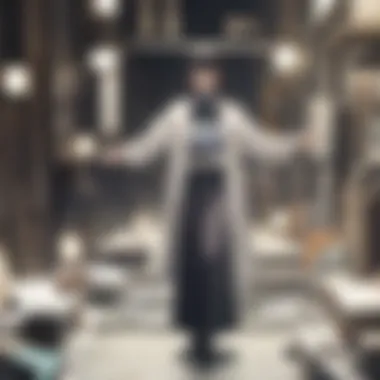Exploring Parables in Television Storytelling


Intro
The relationship between parables and television is profound and complex. Parables serve not only as moral or ethical guides but also as tools that enhance storytelling across genres. They have historical roots that stretch back centuries, influencing how narratives develop and how audiences connect with them. In this exploration, we will uncover the various layers of parabolic narratives in television.
Overview of Parables in Television
In essence, parables are succinct stories that convey deeper meanings. Television, as a medium, allows for these narratives to expand into rich realms of emotions and thoughts. From dramas to comedies, parables can be found woven into the fabric of storytelling. Shows like "The Good Place" and "Breaking Bad" utilize these elements to provoke thought and stimulate discussions among audiences.
Historical Context
The use of parables in storytelling has historical significance. Originating from religious texts and folklore, parables have conveyed moral lessons since ancient times. Television continues this legacy, adapting age-old themes to modern contexts. Understanding this evolution illuminates why audiences resonate with such tales.
Impact on Audience Perception
Television viewers engage deeply with narratives that reflect their values and dilemmas. Parabolic storytelling taps into these emotions, fostering a profound connection between the viewers and the characters. This connection transcends mere entertainment; it encourages reflection on personal beliefs and societal norms.
Historical Context of Parables
Understanding the historical context of parables enriches our comprehension of their role in television narratives. Parables have long served as effective tools for storytelling, offering moral lessons through simple yet profound tales. Their significance lies in their ability to convey complex ideas in a digestible format. They foster a connection between the viewer and the narrative, often resonating deeply due to their intrinsic moral teachings.
Origins of Parables
The origins of parables can be traced back to ancient civilizations. They emerged as oral traditions, used by storytellers to impart wisdom and ethical guidance. One of the earliest documented uses of parables can be found in religious texts, particularly the Bible and the teachings of Confucius. These primitive narratives often featured relatable characters facing dilemmas, allowing audiences to draw personal conclusions about right and wrong.
Moreover, the storytelling tradition around parables emphasized simplicity and clarity. This accessible nature made them suitable for various demographics, ensuring their longevity through generations. Many of the themes presented in these early parables remain relevant today, proving that their foundations are timeless and continue to shape modern narratives across different mediums, including television.
Parables in Ancient Cultures
In ancient cultures, parables served multiple purposes. They were tools for education, entertaining social commentary, and a means of preserving cultural heritage. Societies like those of the Greeks and Romans utilized parables to discuss philosophical and ethical matters. The Aesop's Fables, for example, is one notable collection where animals embody human traits to illustrate moral lessons.
Additionally, in Eastern cultures, parables played a similar role. For instance, Buddhist teachings often used parables to convey profound insights about human nature and existence. Each parable presented not just a story but also an invitation for self-reflection, implicating the audience in their moral journey. Through these ancient narratives, societies cultivated a sense of identity and community.
Evolution of Parables Through Time
The evolution of parables is marked by their adaptation to new forms of storytelling. As societies progressed, so did the formats in which these narratives were told. While oral traditions dominated initially, the advent of written language allowed for wider dissemination. With printing technology, books containing parabolic tales became accessible to larger audiences.
In modern times, parables have transformed with advancements in media. Television, as a storytelling medium, has seen parables adapted into episodic formats. TV shows often weave parabolic elements into their story arcs, enabling complex themes to unfold over time while maintaining viewer engagement. This evolution encapsulates how parables retain their relevance, evolving while still embodying essential moral lessons.
In summary, the historical context of parables highlights their foundational role in storytelling. Their origins, uses in ancient cultures, and evolution provide a framework to appreciate their ongoing impact in contemporary television narratives.
Television as a Storytelling Medium
Television has become a significant platform for storytelling, shaping how narratives are constructed and consumed today. This medium provides creators with a unique canvas that blends visual artistry, sound, and written dialogue. The dynamic nature of television allows for complex storytelling that can evolve over time. In the context of parables, television serves as a particularly apt medium for conveying moral and thematic lessons through relatable characters and plots.
Important Elements of Television as a Storytelling Medium


- Visual Engagement: The sight and sound combination enhances storytelling, making experiences more immersive for viewers.
- Serial Format: Stories can develop extensively across episodes, allowing for deeper character arcs and gradual moral exploration.
- Cultural Relevance: Television often reflects societal values, making the messages of parables resonate with contemporary issues.
The Rise of Television Narrative
In the last few decades, narratives in television have risen to prominence. Gone are the days of simplistic plots. Now, shows like Breaking Bad and The Crown fascinate audiences with their intricate narratives and character development. This narrative depth opened avenues for parables to flourish, as writers strive to embed moral questions and social commentary into their stories. The success of television dramas has prompted a recognition of its legitimacy as a storytelling form comparable to literature or film.
Cinematic Techniques in Television
Television has borrowed many cinematic techniques that enhance storytelling. High-quality cinematography, sound design, and editing techniques elevate television narratives. This shift in production quality means that parables can be presented with visual storytelling that reinforces their ethical messages. For instance, the use of color grading can symbolize character feelings and evolution. Techniques like flashbacks or non-linear storytelling can further deepen the viewers' understanding of thematic elements.
"The rise of cinematic techniques in television enables storytellers to explore complex moral theories through visual narratives that invoke emotional responses."
Integration of Themes in Modern TV Shows
Modern television shows skillfully weave various themes together, showcasing human experiences, morality, and societal reflections. Writers use parabolic narratives to explore conflicts between individual desires and societal norms, often illuminating essential dilemmas that resonate with viewers. Themes such as redemption, morality, and identity are common. They draw audiences into reflections on their values and beliefs, inviting deeper contemplation of the fundamental truths within the stories.
Parables as Narrative Devices
Parables have long served as foundational narrative devices across multiple storytelling mediums. Their significance in television cannot be overstated, particularly because they distill complex ideas into easily digestible forms. The capacity of parables to convey moral lessons and provoke contemplation aligns well with the serial format of television. Shows can utilize parables to create emotional connections with their audiences. Such connections enhance viewer engagement and foster deeper understanding of the humanity depicted on the screen.
Defining Parables in Contemporary Context
Defining parables in the modern landscape requires an understanding of their simplification of moral dilemmas and storytelling. In today’s context, parables are brief narratives that convey lessons or truths, often through allegorical means. They differ from more traditional forms of storytelling by intentionally avoiding extensive character backstories or elaborate world-building. Instead, they focus on the essence of the narrative. This is particularly relevant in television, where time constraints often necessitate a concise narrative structure. For example, episodes of series like The Twilight Zone often employ parables to deliver powerful messages within a limited runtime.
Characteristics of Parabolic Storytelling
Parabolic storytelling possesses distinct characteristics that set it apart from conventional narratives. Firstly, parables are marked by their simplicity. The core message is often communicated through straightforward plots and relatable characters. Secondly, they focus on the delivery of moral or philosophical lessons rather than solely on character development or climactic storytelling. This characteristic is effective in shows like Black Mirror, which confronts contemporary issues through parabolic lenses. Additionally, parables frequently employ symbolic elements. Symbols heighten the narrative’s impact, inviting viewers to interpret their meanings and engage with themes critically.
Comparison with Other Narrative Forms
Contrasting parables with other narrative forms underscores their unique role in storytelling. Standard narratives often prioritize character development, plot complexity, and emotional arcs. In comparison, parables streamline these elements. They focus less on character backgrounds and provide clear thematic insights without emotional distractions. In traditional narratives, the development of multi-dimensional characters is essential; however, in parables, character dimensions may be scaled back in favor of emphasizing the lesson conveyed.
Parables function effectively in various genres, including drama, science fiction, and fantasy. This diversity is less common in other narrative forms, which may struggle to adapt across genres while retaining their integrity. An example includes The Good Place, which weaves philosophical quandaries into its framework, operating as both a comedy and a parable that examines morality and ethics.
"Parables engage both the simple and the sophisticated, offering layers of meaning that allow for diverse interpretations."
Impact of Parables on Audience Engagement
The influence of parables on audience engagement in television is profound. Parables serve not only as compelling narrative tools but also as bridges that connect viewers with deeper themes and morals. When crafted skillfully, they provoke discussion and reflection in ways that standard narratives may not achieve. Understanding this impact is crucial for dissecting how stories resonate with those who consume them.
Emotional Resonance in Storytelling
Parables often lead to heightened emotional resonance in storytelling. Their structure allows viewers to form connections with characters and the moral messages being communicated. For instance, in shows like "The Good Place," the exploration of morality through parabolic episodes evokes strong feelings of empathy, as viewers are prompted to consider their own ethical compass. The simplicity of parabolic storytelling enables both complex and relatable emotions to surface, engaging the audience on multiple levels. The shape of the parable simplifies intricate moral dilemmas, allowing audiences to grasp the underlying lessons quickly.
Cognitive Processing of Parabolic Themes
Cognitive processing of parabolic themes offers another layer of audience engagement. Parables challenge viewers to think critically about the narratives presented to them. They often present clear moral questions or dilemmas, enabling audiences to analyze their responses. The audience must engage intellectually with the story to unravel the intended messages. Shows like "Black Mirror" utilize parables to provoke thought about technology and society, pushing audiences to confront uncomfortable realities. This kind of questioning is essential for deeper engagement, encouraging viewers not only to watch but also to reflect on their life choices and societal norms, thus creating more meaningful viewing experiences.


Cultural Interpretations of Parables
Cultural interpretations of parables play a significant role in shaping viewer engagement. Different cultures have varied understandings of moral lessons, and this can influence how a parable is received by its audience. Television shows that leverage culturally specific parables may resonate more deeply with certain demographics, creating a bond based on shared cultural experiences. For example, anime series often intertwine traditional Japanese parables, appealing to audiences familiar with those stories. This cultural underpinning enriches the viewing experience, as audiences draw on their own backgrounds to interpret the narratives. Recognizing the diverse interpretations of parables across cultures is paramount for creating compelling television content.
"The effectiveness of a parable lies not just in its moral but in its ability to spark personal reflection among viewers."
The impact of parables on audience engagement cannot be understated. They stimulate emotional responses, demand cognitive participation, and invite diverse cultural interpretations. As such, parables are indispensable in crafting engaging television narratives that resonate with viewers and spark meaningful interactions.
Case Studies of Parables in Modern Television
Examining case studies of parables in modern television shines a light on their impact in storytelling. These examples reveal how parables not only enrich the narrative but also offer profound lessons. By analyzing these series, we gain insights into how emotional and moral dimensions are embedded within the plot, enhancing audience engagement.
Notable Series Featuring Parabolic Elements
Several television series feature parabolic elements, reflecting deep truths through their narratives. Shows like The Good Place, Black Mirror, and Avatar: The Last Airbender effectively explore moral dilemmas and ethical challenges through their plots.
- The Good Place: This series utilizes philosophical concepts to present parables on morality, ethics, and the human experience. It conveys complex ideas in a relatable format, encouraging viewers to reflect on their own moral choices.
- Black Mirror: Each episode serves as a modern fable, often highlighting the consequences of technological advancements. The story arcs provoke thoughts about society’s ethical trajectories and the human condition.
- Avatar: The Last Airbender: This animation intricately employs parables as it touches upon themes like balance, duty, and redemption, all while delivering heartfelt character journeys.
Overall, these series demonstrate the versatility of parables, allowing them to resonate across different genres and themes.
Character Arcs and Parables
Character development is integral in conveying parables. In many series, themes are mirrored in the evolution of main characters. These arcs often embody the moral lessons presented within the story.
- In The Good Place, characters such as Eleanor Shellstrop experience personal growth that reflects the search for redemption and understanding of ethical values.
- In Avatar: The Last Airbender, Aang’s journey illustrates the importance of balance and overcoming past mistakes, which aligns with the overarching parables of the series.
Through these arcs, audiences witness transformative journeys that reinforce the lessons embedded within parabolic storytelling.
Viewer Reactions and Interpretations
Viewers often react strongly to parables, forming personal connections with the narratives. Reactions can vary from introspection to debates about ethical implications. The nature of parables allows for multiple interpretations, inviting diverse viewer responses.
- Many fans discuss the philosophical questions posed by Black Mirror, reflecting on the implications of technology on society in forums or social media.
- Likewise, The Good Place prompts conversations about morality that extend beyond the show, encouraging viewers to consider their own lives and decisions.
Thus, parables in television often extend their impact beyond the screen, fostering community discussions and deeper reflections on human nature and society.
"Parables serve a greater function; they encourage the audience to think critically about their own beliefs and values."
Thematic Analysis of Parables in TV
The thematic analysis of parables in television plays a vital role in understanding how these narrative devices convey complex ideas and moral lessons. It explores the underlying messages embedded within episodic storytelling and how these narratives resonate with audiences. Parables often serve as a bridge between the extraordinary and the commonplace. They help viewers grapple with ethical dilemmas and cultural values in a way that is accessible and relatable. Consequently, examining themes in parabolic narratives can reveal significant insights into societal norms while demonstrating the power of storytelling in the medium of television.
Moral Lessons in Parabolic Narratives
Moral lessons form the backbone of parabolic narratives. Television shows frequently utilize parables to illustrate ethical or moral dilemmas faced by characters. In shows like The Good Place, characters navigate complex moral landscapes, prompting viewers to reflect on their own values and decisions. Each parable teaches a lesson, often through the struggles and growth of the individuals involved.


- Clarity of Message: One notable benefit of employing parables is their ability to deliver clear moral lessons. For instance, Breaking Bad serves as a cautionary tale about the consequences of choices.
- Engaging Format: The use of parables creates an engaging format that can consolidate complex ideas about morality into digestible narratives. Consequently, it engages the audience on an emotional and intellectual level, urging deep reflection.
Role of Conflict in Parables
Conflict is a critical component of parabolic storytelling. It drives the narrative forward and forces characters to face their flaws and challenges. In Game of Thrones, for example, moral conflicts propel characters into situations where they must make tough decisions that showcase their core values. These conflicts not only enhance narrative tension but also facilitate moral exploration.
- Character Development: Conflicts highlight the characters' growth and transformation. In The Walking Dead, the post-apocalyptic context amplifies moral choices, pushing characters to reveal their true selves.
- Audience Engagement: The complexity of conflicts encourages viewers to engage deeply. They often lead to discussions about right and wrong, showcasing parables as a means of exploring intricate human experiences.
Resolution and Transformation Themes
Resolution and transformation are essential themes within parables. These elements demonstrate how characters evolve in response to their experiences. Shows like Avatar: The Last Airbender exemplify this through the protagonist's journey from an immature child to a mature leader. The resolution of conflicts often delivers significant moral lessons, reinforcing the core teachings of the parables.
- Symbolic Endings: The conclusions of these stories frequently reflect the moral teachings of the narratives, illustrating how characters confront and overcome their challenges.
- Reflecting Societal Change: Moreover, transformations in parables often mirror societal changes or challenges, indicating a broader cultural narrative. They prompt viewers to consider their own potential for change and growth.
"Parables in television serve not just as entertainment but as a means for introspection and understanding of human values."
In summary, thematic analysis of parables in television illuminates their role as vital storytelling tools that communicate moral lessons, highlight conflict, and showcase transformative journeys. This analysis not only enriches the viewing experience but also provokes thought and reflection among audiences.
The Future of Parables in Television
The future of parables in television holds significant relevance in the ongoing evolution of storytelling. As the medium continues to develop, parables remain a vital part of narrative techniques. They offer viewers insight into moral lessons, cultural values, and complex human behaviors. The integration of parables in television is not merely a trend; it serves essential functions in character development and thematic exploration. In the contemporary landscape, it is important to recognize how emerging technologies and storytelling formats affect these narrative devices.
Emerging Trends in TV Storytelling
Several trends suggest a resurgence of parabolic storytelling within television. Streaming platforms allow diverse types of narratives to flourish. Audiences expect layered storytelling, and parables provide that, engaging viewers with deeper meanings. Shows like "The Good Place" exemplify how philosophical questions are explored through seemingly simple narratives, making complex ideas accessible. Furthermore, serialized storytelling creates opportunities for parables to evolve over multiple episodes, enhancing their impact.
- Complex Character Arcs: Characters often represent moral dilemmas or philosophical ideas, inviting viewers to reflect on their own values.
- Diverse Perspectives: Many modern shows are showcasing cultural parables, tapping into a wider range of traditions and experiences.
- Interactive Viewing: With social media, viewers engage not only with the content but also with each other's interpretations of parables. This interaction enriches the narrative experience.
Potential Challenges of Parabolic Storytelling
Despite the promising future, certain challenges loom over parabolic storytelling. One significant issue is the risk of oversimplification. In a quest for accessibility, some shows may gloss over complexities. The subtleties that make parables meaningful can be lost. Additionally, audience expectations for immediate gratification conflict with the slower pacing often found in parabolic narratives.
- Cultural Sensitivity: Representation matters. Creators must approach parables from various cultures with caution to avoid misinterpretation or appropriation.
- Viewer Fatigue: There is a danger of viewers becoming overwhelmed. As story arcs become increasingly complex, the risk of disengagement increases.
- Market Demand: Networks may prioritize profit over artistry, leading to an oversaturation of similar narratives. The uniqueness of parables may suffer as a result.
Opportunities for Creative Expression
Amid these challenges, numerous opportunities for creative expression exist. Writers can explore innovative methods to weave parables into narratives, making use of new technologies. For example, virtual reality (VR) could immersive audiences even deeper into a story's moral fabric. Furthermore, there is a rise in niche programming that values depth over broad appeal, providing space for experimental storytelling forms.
- Cross-Genre Blending: Combining genres can create unexpected depth. A science fiction show may incorporate traditional parables, offering fresh perspectives.
- Unique Formats: Anthology series allow for standalone narratives that can examine various parables without the need for extensive character development.
- Collaborative Storytelling: Platforms such as Reddit enable writers to engage directly with audiences, creating stories that genuinely resonate with viewers.
Closure
In this article, we have explored the significance of parables within the realm of television storytelling. Parables serve as powerful narrative devices that carry moral lessons and ethical dilemmas, resonating deeply with audiences. Their ability to encapsulate complex themes in a simple format allows for an enhanced engagement between the viewer and the narrative. Understanding how parables function not only enriches our appreciation for these stories but also sheds light on the broader storytelling techniques employed in modern television.
Summation of Key Insights
The analysis reveals several key insights:
- Historical Roots: Parables possess a rich history that spans various cultures and epochs. They serve as a testament to the enduring nature of storytelling, engaging audiences across generations.
- Emotional Resonance: The use of parables in television evokes strong feelings. Audiences connect with characters and their journeys, leading to a more immersive experience.
- Cognitive Engagement: Parables encourage viewers to think critically about moral and ethical issues presented in the story. This engagement heightens the impact of the narrative.
- Interactivity of Themes: The thematic interplay in parabolic narratives allows viewers to derive multiple meanings, encouraging personal interpretation and reflection.
- Future Opportunities: As television continues to evolve, the potential for innovative parabolic storytelling remains vast. New formats and allusions can bring fresh life to these age-old narratives.
Final Thoughts on Parables in TV
Ultimately, parables in television serve as a mirror reflecting societal values and challenges. They inspire discussions and ponderings on morality, ethics, and humanity’s condition. As viewers become more discerning and seek content that resonates on a deeper level, the relevance of parables will continue to grow. The narrative constructs of shows can be significantly enriched by weaving parables into their fabric, often resulting in more profound viewer experiences. In this evolving tapestry of media, parables remain an essential thread—connecting the past with the present, and the viewer with the narrative.















